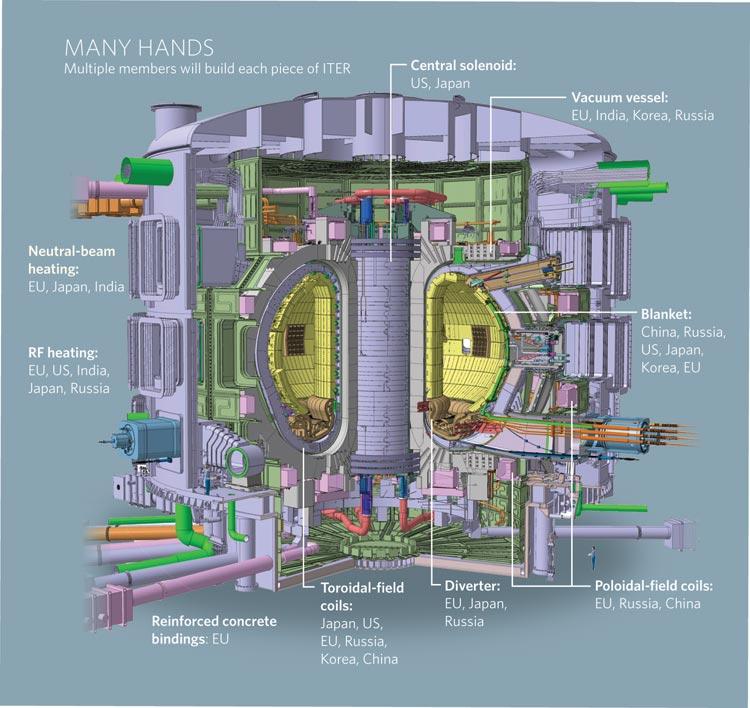An international nuclear fusion project, known as Iter, has been making progress by finally gaining approval for the design of a component that will be one of the most challenging to install. In a forest of Provence in the south of France, there has been the construction of a site that’s purpose will be to harness the nuclear power of the sun and stars. 34 nations have joined together in what is known to be “the biggest scientific collaboration on the planet.” If this project succeeds, then global energy demand will increase by three-fold, and it will change our world that has been struggling with the fight against climate change.
This highly complex fusion reactor will be built with about a million individual parts and each component will come from different regions built around the world. Then it will be assembled “like a giant Lego model” in a building near the site. These individual parts can get as big as small houses, and the building they’re assembling it at is equal to 81 Olympic-sized swimming pools. I already cannot imagine what it will take and has taken to bring so many countries together and decide what is going to be built where. It reminds me back to one of our first classes where we made the paper fortune tellers and how it took majority of the class to work together and complete the project.
Complexity of Iter has been proven through the length it had taken to reach the initial stages of construction. The earliest start time for this project dates back to 1985 with meetings and discussions between the nations. Today, scientists involved have claimed it will still take another ten years of building work and an extra ten years after that for testing the reactor before it can go online. If you were one of the managers on the team for this project, how would you being planning and creating a Precedence Diagram? Do you think there could be multiple critical paths in a project like this? One of my concerns about an enormous project is the time it takes to complete it. Over time, information becomes stale and the technology used becomes outdated because of the changing markets.
A critical phase of the project is injecting plasma, a super-hot electrically-charged atomic fuel, and it is scheduled for November 2020; unfortunately, because we do not live in a perfect world, there have been delays that pushed this phase back to October 2022. An unforeseen circumstance where a worker left a towel on one of the superconducting cables became compressed within the coil causing extra work by scraping off the debris left behind. I believe this is a perfect opportunity for the project managers to consider crashing this project because it is becoming behind schedule. Do you think that crashing a critical path in such a big project dealing with nuclear reactors would be a good idea to enable them to finish the project by the due date?


The idea of Iter, a grandiose nuclear fusion project, is incomprehensible to me. I am amazed at the collaboration of so many different countries and impressed that they were able to efficiently communicate in the 1980s and 1990s. As technology advances, information and data will become obsolete but it may not delay the project launch date. With a project of this size, I am sure there are many critical paths and ways of crashing, but technology will speed up the process of constructing the project in ways that were not available or possible at the start time of Iter. The precedence diagram could now most likely be created through computer software and could easily be updated in order to reflect the progress of each stage. I am interested to see where this project goes in the next 20-30 years.
I think in a project of this magnitude, it would be irresponsible to crash any part of the critical path. Getting the job done correctly is much more important than finishing on time. If project managers were to rush a portion of this project and it turned out badly, they would look awfully silly.
I agree with the first comment. It is really fascinating how there are a collaboration of so many different countries. It shows how important this project is and how everyone wants to be a part of it. In my opinion, I would not crash a project that means so much. Like stated above, this is something with high importance and you wouldn’t want to mess things up by crashing the critical path. This project means much more than just time. It makes sense for the project managers to take their time with this project and try to make sure it is done correctly. Maybe you would crash the critical path if it was a project that didn’t mean as much to the world, but this project is important.
It is amazing that 34 different nations have been working on this project for close to thirty years and will continue to do so for a minimum of ten more. Any time that a project is dealing with new and complex technology with over a million moving parts, the project is going to take a long time. If they can create this technology it will be truly amazing and will have major implications for the way the world will derive its future energy needs. As far as crashing goes, they might run into trouble with how technical and intricate the work is. There probably aren’t many technicians skilled enough to handle this type of job. Also, one small mistake, like the guy leaving a towel on the coil, can set the project back in time and money to a point where it would completely negate any time saved by crashing.
One thing I didn’t understand was the statement “if this project succeeds, then global energy demand will increase three-fold”. What is the correlation here?